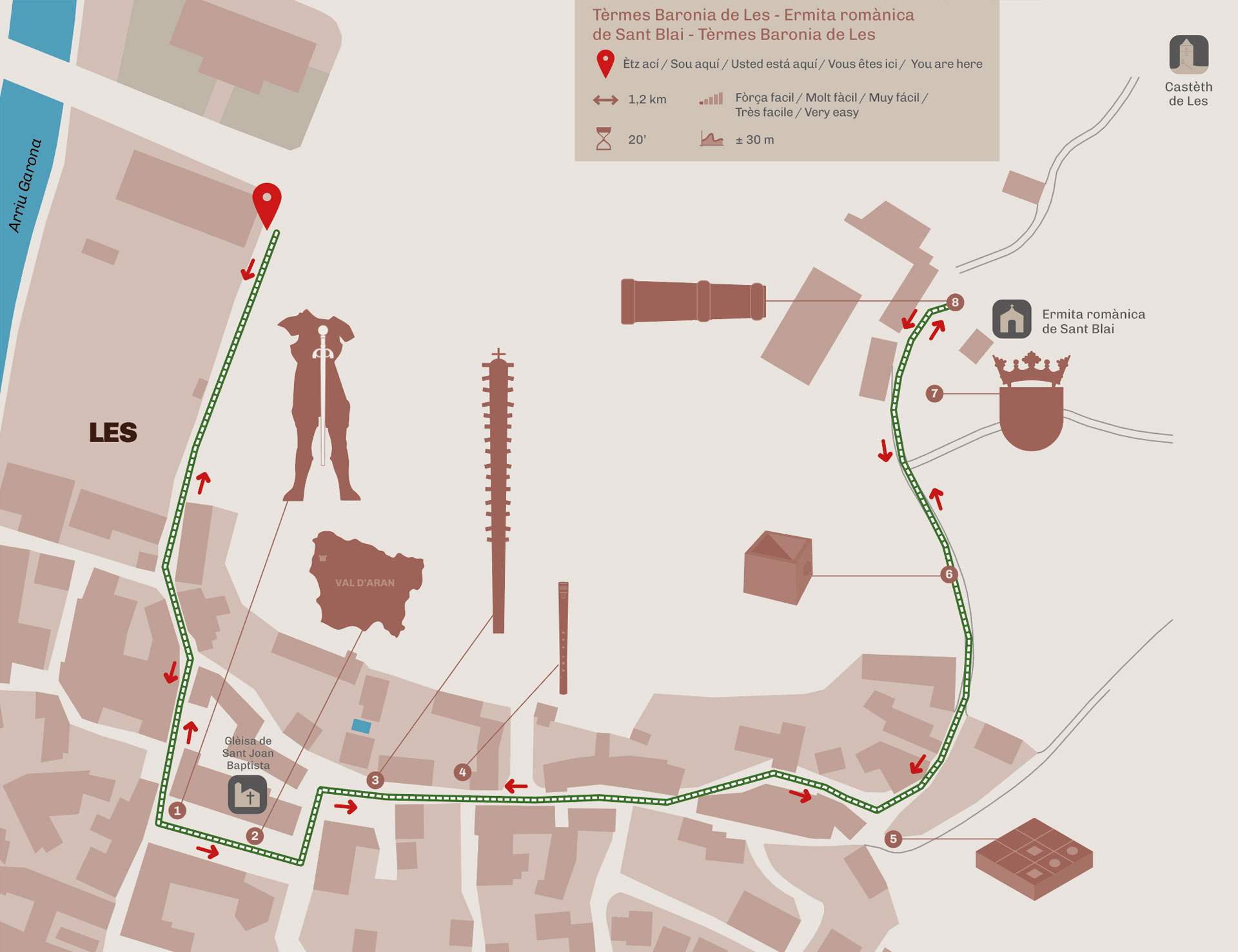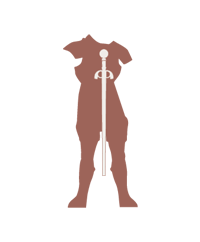

Discover the magic of Les and its
fortress, on an itinerary that will take you back in time.
Each point along the way reveals a chapter of its history. The area’s archaeological remains and written documentation reveal its strategic and unique past in Val d’Aran. Enjoy a cultural experience that combines nature with history.

1. Sword
Here you will find a replica of the 15th-century iron sword that emerged during the archaeological excavations conducted in the castle in the 1990s.
Measuring just over a metre in length, this sword was found inside a wooden sheath that had become fused to the iron blade, probably due to the fire that ultimately destroyed the fortress.
Different pieces of artillery were also documented, such as arrowheads, crossbow bolts, spearheads, a front-loading cannon and projectiles.
However, no armour was found. This is an approximate illustration based on knight’s armour dating from the same period as that of the sword.
The original sword is on display at the Museum of Val d’Aran (Vielha).

2. Map
This was a crucial territory for the control of the border between the Crown of Aragon and the counties of Occitania, which would later become part of the Kingdom of France. Within this context, both the town of Les and the castle were of fundamental importance.
Interestingly, in 1265 King Jaume I “the Conqueror” visited the castle of Les and spent a night there. Because the lord of Les, Auger de Berbadar, was known to sympathise with the French, the monarch reminded him of his duty of fealty as a vassal. Thus, he asked three men from the castle to proclaim their loyalty to him, and ordered the royal flag to be hung on the top of the tower. Although this visit became an act of submission, Auger de Berbadar himself would help the French troops to enter and invade the territory of Aran, in 1283.

3. The Haro (Trunk of a fir tree)
The Haro is the splintered trunk of a fir tree, measuring some 11-12 metres long. It is planted in the middle of the square, where it remains until the festivities of the Eve of Sant Joan (23 June). A week later, on the day of Sant Pere (29 June), during the Quilha deth Haro ceremony, a new one is planted, which is prepared during the Shasclada (in May).
In Val d’Aran, the crema deth Haro, the tradition of burning the tree trunk, has been documented since the 17th century, yet it is likely to have pre-Christian origins as a ceremony linked to fertility during the summer solstice.
The culture, experience and celebration around the Haro are very important for the local people and have been handed down from generation to generation as a unique and deeply-rooted part of their identity; a tradition that is still very much alive today.
In 2015, UNESCO added the Summer Solstice Fire Festivals in the Pyrenees to its Representative List of Intangible Cultural Heritage.
Where do you think the name Haro comes from?
a) From the Latin word arum (‘ring’), referencing the engagement rings worn by couples who are married and bring a crown of flowers to the Haro.
b) From the Latin word pharos, which comes from the Greek pharos (‘beacon’), referring to the light given off by the burning log.
c) From the Latin word arare (‘to plough’), relating to soil cultivation, which is aided by the ashes and charcoal from the burnt log.

4. Flute
In the Middle Ages, music was a cultural legacy passed down through songs with short, simple verses that were easy to remember and repeat.
Depending on the context and the instruments, they expressed moments of sadness and solemnity, as well as joy and love. Sacred music in churches and popular music at village festivals generated ties among the members of the community. These were moments of shared camaraderie, family and tradition.
The flute was a popular instrument in Aran, Gascony and Catalonia. It was generally made of wood, which is why so few examples of these instruments can be found today. Some flutes had three holes, others six, and they were accompanied by percussion instruments.
The flute is an instrument that continues to be played by most of today’s Aranese traditional and folkloric music groups.

5. Board game
Of all the objects and materials documented in the archaeological excavations, one of the most intriguing was a small 2 × 2 cm die made of bone.
We do not know exactly what game was played with this die, but we do know that the inhabitants of the castle spent many hours there, particularly in winter, so board games were undoubtedly a popular form of entertainment.
Here is another famous board game: noughts and crosses. Fancy a game?

6. The galin (unit of measurement)
The galin is a unit of measurement originating in Aran in the form of a cut-off quadrangular pyramid with a slightly variable volume of around 10.5 litres.
The unit of grain, normally wheat, was the only tax that each Aranese household had to pay to the king once a year.

7. The coat of arms of Les
The layout of the coat of arms of Les follows the traditional patterns of the coats of arms of the Crown of Aragon.
The royal crown at the top, as a symbol of loyalty to the King and the Crown, is an element that appears on all the coats of arms in Aran.
Below this is one of the most distinctive elements: the Baron’s crown. The lordship and, later, the barony were the only feudal systems different from the rest of the valley, which was under royal control.
The key appears in the opposite position to that of the Aranese coat of arms. According to local sources, this alludes to the role of the lords and barons of Les, who many times throughout history opened their doors to the French, acting against the interests of the Crown and often opposing the will of the townspeople.
In the centre is the castle’s keep, guarded by two lions, which are thought to refer to Castèth Leon (Es Bòrdes).
The coat of arms of Les clearly conveys the uniqueness and history of this town.

8. Cannon and projectiles
Inside the castle, a small bronze cannon was found, along with stone and iron projectiles measuring between 2.5 and 4 centimetres. The cannon is 33 centimetres long, 10 centimetres in diameter at its widest point, and weighs about 12 kg. The piece you see here is a full-scale replica of the original.
The cannon’s size enabled it to be moved quickly and relatively easily over uneven and hilly terrain. Based on its design, we know that it was mounted to a wooden structure gun carriage known as a curenya.
The original cannon and projectiles are on display at the Museum of Val d’Aran (Vielha).








